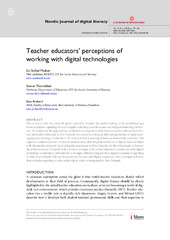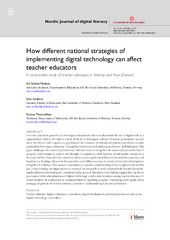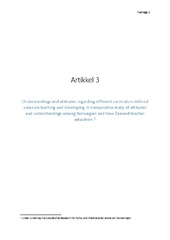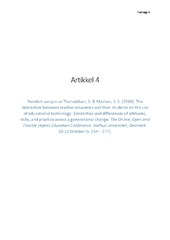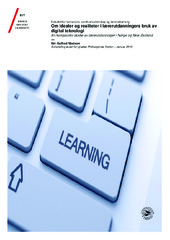| dc.contributor.advisor | Lund, Øystein | |
| dc.contributor.author | Madsen, Siri Sollied | |
| dc.date.accessioned | 2019-04-15T10:46:02Z | |
| dc.date.available | 2019-04-15T10:46:02Z | |
| dc.date.issued | 2019-05-02 | |
| dc.description.abstract | Compared to most other countries, Norway has been exposed to a stronger top-down implementation of information and communication technologies (ICT) in education. The pervasive change in the Norwegian school curriculum has consequently resulted in changes in Norwegian initial teacher education. Over 10 years have passed since Norwegian educational reforms mandated teachers’ use of digital tools as a required basic skill in all subjects and at all levels of Norwegian schooling. However, government surveys show that there is still a significant gap between the aim of educational policies and what is actually practised in Norwegian teaching. This gap has often been attributed to deficiencies in practitioners’ skills. This thesis aims to broaden the understanding of the established gap between policies regarding the use of digital technology and the actual use of digital technology in Norway. To understand this gap a comparative study between teacher education in Norway and teacher education in New Zealand is conducted. This is two countries with quite different approaches to implementing digital technology in education, and we found several interesting differences between the countries. | en_US |
| dc.description.doctoraltype | ph.d. | en_US |
| dc.description.popularabstract | Government surveys show that there is still a significant gap between the aim of educational policies and what is actually practised in Norwegian teaching. This gap has often been attributed to deficiencies in practitioners’ skills. This thesis aims to broaden the understanding of the established gap between policies regarding the use of digital technology and the actual use of digital technology in Norway. To understand this gap a comparative study between teacher education in Norway and teacher education in New Zealand is conducted, with both qualitative and quantitative methods applied. The regression analysis and the correlation analysis show that the professional use of digital tools correlates with the teacher educators’ level of digital competence in New Zealand. On the other hand, in Norway the professional use of digital tools correlates stronger with teacher educators’ attitudes towards digital technology in education. These findings were further investigated through in-depth interviews of Norwegian and New Zealand teacher educators. Based on both quantitative and qualitative findings, I discuss how such differences may be connected to policy development and political influence. This thesis contributes to a broader understanding of the complex factors creating the gap between policy and practice, and understanding the bigger picture is essential to working constructively towards bringing policy intentions and practice closer together in the future. | en_US |
| dc.description.sponsorship | Stipendiat ved UiT Norges Arktiske Universitet | en_US |
| dc.identifier.uri | https://hdl.handle.net/10037/15209 | |
| dc.language.iso | nob | en_US |
| dc.publisher | UiT Norges arktiske universitet | en_US |
| dc.publisher | UiT The Arctic University of Norway | en_US |
| dc.relation.haspart | <p>Paper I: Madsen, S.S., Thorvaldsen, S. & Archard, S. (2018). Teacher educators' perceptions of working with digital technologies. <i>Nordic Journal of Digital Literacy, 13</i>(3), 177-196. Also available at <a href= https://hdl.handle.net/10037/15203> https://hdl.handle.net/10037/15203</a>.
<p>Paper II: Madsen, S.S., Thorvaldsen, S. & Archard, S. (2018). How different national strategies of implementing digital technology can affect teacher educators. <i>Nordic Journal of Digital Literacy, 13</i>(4), 7-23. Also available at <a href= https://hdl.handle.net/10037/15204> https://hdl.handle.net/10037/15204</a>.
<p>Paper III: Madsen, S.S. Understandings and attitudes regarding different curriculum defined views on learning and developing. A comparative study of attitudes and understandings among Norwegian and New Zealand teacher educators. (Submitted manuscript).
<p>Paper IV: Revised version of Thorvaldsen, S. & Madsen, S.S. (2018). The interaction between teacher educators and their students on the use of educational technology: Similarities and differences of attitudes, skills, and practice across a generational change. <i>The Online, Open and Flexible Higher Education Conference. Aarhus Universitet, Denmark. 10-12 October</i>, 264-277. Also available at <a href= https://hdl.handle.net/10037/15207> https://hdl.handle.net/10037/15207</a>. | en_US |
| dc.rights.accessRights | openAccess | en_US |
| dc.rights.holder | Copyright 2019 The Author(s) | |
| dc.rights.uri | https://creativecommons.org/licenses/by-nc-sa/4.0 | en_US |
| dc.rights | Attribution-NonCommercial-ShareAlike 4.0 International (CC BY-NC-SA 4.0) | en_US |
| dc.subject | VDP::Social science: 200::Education: 280::General education: 281 | en_US |
| dc.subject | VDP::Samfunnsvitenskap: 200::Pedagogiske fag: 280::Allmennpedagogikk: 281 | en_US |
| dc.subject | VDP::Technology: 500::Information and communication technology: 550 | en_US |
| dc.subject | VDP::Teknologi: 500::Informasjons- og kommunikasjonsteknologi: 550 | en_US |
| dc.title | Om idealer og realiteter i lærerutdanningers bruk av digital teknologi. En komparativ studie av lærerutdanninger i Norge og New Zealand. | en_US |
| dc.type | Doctoral thesis | en_US |
| dc.type | Doktorgradsavhandling | en_US |


 English
English norsk
norsk
